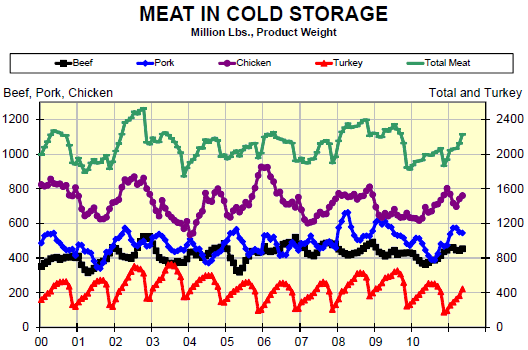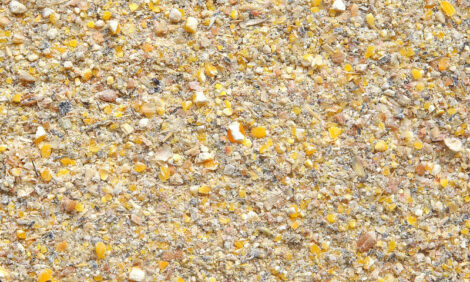



CME: Highlights of Latest <em>Cold Storage</em> Report
US - USDA’s monthly Cold Storage report, released Wednesday, 22 June, shows significantly larger stocks of frozen meat and poultry in US cold storage facilities relative to one year ago and modest increases in inventories versus one month ago, write Steve Meyer and Len Steiner.There were 2.228 billion pounds of meat/poultry in freezers
as of 31 May, 11.6 per cent more than last year and 4.9 per cent more than at
the end of April.
The data for all meat/poultry species appear in the table
on page 2 (please see link below). The chart below depicts monthly inventories of the
four major meat/poultry species since 2000.

Some highlights of the report are:
- Beef, pork and chicken inventories increased relative to one
year ago with beef leading the increases at +25.5 per cent. 90 per cent of
that increase was accounted for by higher boneless beef
stocks. That latter relationship almost always has to be true
since boneless beef almost always accounts for 85-90 per cent of
beef in cold storage.
- Frozen pork inventories were 22.2 per cent higher versus one year
ago. One factor driving that increase is the emergence of
Korea as a major export market in the wake of their foot and mouth disease outbreak. Stocks of frozen pork butts, a key Korean
export item, were 99.5 per cent higher this year versus one year ago.
- Chicken inventories increased 9.8 per cent versus one year ago. The increase was led in percentage terms by wings (+72.2 per cent) and in tonnage
terms by breast/breast meat at +41.13 million pounds. It is little surprise that those two cuts have been major drags on chicken
values this year. On the other hand, stocks of leg quarters, thigh/thigh quarters and thigh meat were all below one year ago, facts
that again support the relative strength of leg quarter prices so far in 2011.
- Turkey inventories were, quite understandably, larger than one month ago (+21.8 per cent) as the sector builds stocks for its seasonal trade
this fall but were 3.9 per cent lower than one year ago. The discipline of the turkey sector has been very remarkable over the past three
years as they manage supply-demand relationships well and keep prices high enough to cover costs and still make money.
- Month-month inventory changes were positive for each species except pork but the increases in both chicken and beef stocks were relatively small at 2.5 and 2.4 per cent, respectively. Pork inventories fell by 0.8 per cent during May and the decline would have been much more dramatic had it not been for a 31.8 per cent increase in ham inventories. Those ham stocks of 101.5 million pounds were 9.2 per cent larger than last year as well. We attribute this month-month increase primarily to the unusual decline of ham inventories in April which, in most years, is the month in which ham stocks begin to increase toward their September peak. A major driver of that April draw-down was this year’s very late date for Easter. Bottom line: The increase of ham inventories in March doesn’t worry us.
We expect frozen meat and poultry stocks to begin declining this month and for that decline to be larger in July and August. The
seasonal decline in hog slaughter as well as what is developing as a major drop in average hog weights will reduce pork supplies and
increase the drawdown of pork stocks. We are hearing widespread anecdotal evidence that South Korea is back in the market for US
pork —not to the degree they were in April but much more aggressively than in May. In addition, recent reductions in broiler egg sets and
chick placements will show up as lower broiler slaughter and, we think, production in July and beyond, perhaps reducing production
enough that some of the large stocks of breasts/breast meat and wings can be depleted. Those declines will obviously be offset to some
degree by the normal increase of turkey stocks. But that increase is quite normal and fully expected.
The past two days have seen record-high cash hog prices. The Iowa-Minnesota weighted average negotiated base price
broke $100/cwt carcass for the first time ever on Tuesday and then went even higher yesterday reaching $101.65. The top of the range
paid for pigs in Iowa-Minnesota was a whopping $106.00 yesterday. The Western Cornbelt (of which Iowa-Minnesota is a subset)
weighted average negotiated base price also eclipsed $100, reaching $101.49 yesterday. The national weighted average price, which
also includes prices in the Eastern Cornbelt, fell just short of the $100 mark at $99.93.
Further Reading
| - | You can view the full report by clicking here. |








